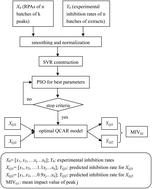当前位置:
X-MOL 学术
›
Anal. Methods
›
论文详情
Our official English website, www.x-mol.net, welcomes your
feedback! (Note: you will need to create a separate account there.)
Anticancer component identification from the extract of Dysosma versipellis and Glycyrrhiza uralensis based on support vector regression and mean impact value†
Analytical Methods ( IF 2.7 ) Pub Date : 2017-12-19 00:00:00 , DOI: 10.1039/c7ay02465g Hailiu Fan 1, 2, 3, 4, 5 , Jianbang Xuan 1, 2, 3, 4, 5 , Kaixuan Zhang 1, 2, 3, 4, 5 , Jianlan Jiang 1, 2, 3, 4, 5
Analytical Methods ( IF 2.7 ) Pub Date : 2017-12-19 00:00:00 , DOI: 10.1039/c7ay02465g Hailiu Fan 1, 2, 3, 4, 5 , Jianbang Xuan 1, 2, 3, 4, 5 , Kaixuan Zhang 1, 2, 3, 4, 5 , Jianlan Jiang 1, 2, 3, 4, 5
Affiliation

|
The good therapeutic effect of herbal medicines depends on their abundant components and it's extremely necessary to find out the main bioactive ingredients. In this paper, the extract of Dysosma versipellis and Glycyrrhiza uralensis was studied for the first time by chemometrics. A HPLC-UV method was developed and validated to establish fingerprint spectra of 46 batches of different samples and a total of 45 common components of all samples were quantitatively and qualitatively analyzed using HPLC-UV and UPLC-Q-TOF-MS/MS, respectively. The anticancer effect of the extract was obtained by MTT (3-(4,5-dimethylthiazol-2-yl)-2,5-diphenyltetrazolium bromide) assay on HeLa cells. After that, a support vector regression (SVR) model optimized by particle swarm optimization (PSO) was constructed to depict the relationship between the chemical constituents and anticancer effect of the extract. Then the mean impact value (MIV) method was introduced to evaluate the bioactivity of the concerned components based on the optimal SVR–PSO model. The results showed that the developed model has an excellent fitting accuracy and generalization ability, and a ranking of the components for their anticancer activity was obtained. The employed strategy provides an efficient and convenient access to active anticancer constituents from the extract of D. versipellis and G. uralensis. The identified components provide explicit guidance for screening anticancer compounds and the developed model can be used for predicting the activity of new samples.
中文翻译:

基于支持向量回归和平均影响值† 的香豆草和甘草提取物中的抗癌成分鉴定
草药的良好治疗效果取决于其丰富的成分,因此非常需要找出主要的生物活性成分。本文主要研究了紫草和甘草的提取物。由化学计量学首次研究。建立并验证了HPLC-UV方法以建立46批不同样品的指纹图谱,并分别使用HPLC-UV和UPLC-Q-TOF-MS / MS定量和定性分析了所有样品中总共45种共有成分。通过MTT(3-(4,5-二甲基噻唑-2-基)-2,5-二苯基溴化四溴化铵)分析获得提取物对HeLa细胞的抗癌作用。之后,构建了通过粒子群优化(PSO)优化的支持向量回归(SVR)模型,以描述提取物的化学成分与抗癌作用之间的关系。然后,基于最佳SVR-PSO模型,引入了平均影响值(MIV)方法来评估相关组件的生物活性。结果表明,所开发的模型具有良好的拟合精度和泛化能力,并获得了其抗癌活性的成分等级。所采用的策略提供了一种有效而方便的途径,可从提取物中提取活性抗癌成分。D. versipellis和G. uralensis。鉴定出的成分为筛选抗癌化合物提供了明确的指导,开发的模型可用于预测新样品的活性。
更新日期:2017-12-19
中文翻译:

基于支持向量回归和平均影响值† 的香豆草和甘草提取物中的抗癌成分鉴定
草药的良好治疗效果取决于其丰富的成分,因此非常需要找出主要的生物活性成分。本文主要研究了紫草和甘草的提取物。由化学计量学首次研究。建立并验证了HPLC-UV方法以建立46批不同样品的指纹图谱,并分别使用HPLC-UV和UPLC-Q-TOF-MS / MS定量和定性分析了所有样品中总共45种共有成分。通过MTT(3-(4,5-二甲基噻唑-2-基)-2,5-二苯基溴化四溴化铵)分析获得提取物对HeLa细胞的抗癌作用。之后,构建了通过粒子群优化(PSO)优化的支持向量回归(SVR)模型,以描述提取物的化学成分与抗癌作用之间的关系。然后,基于最佳SVR-PSO模型,引入了平均影响值(MIV)方法来评估相关组件的生物活性。结果表明,所开发的模型具有良好的拟合精度和泛化能力,并获得了其抗癌活性的成分等级。所采用的策略提供了一种有效而方便的途径,可从提取物中提取活性抗癌成分。D. versipellis和G. uralensis。鉴定出的成分为筛选抗癌化合物提供了明确的指导,开发的模型可用于预测新样品的活性。











































 京公网安备 11010802027423号
京公网安备 11010802027423号